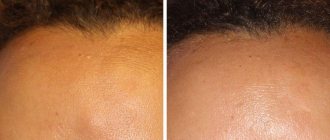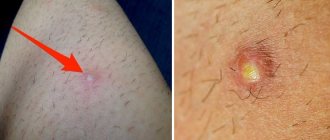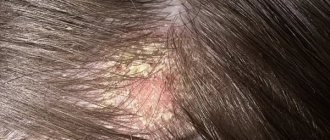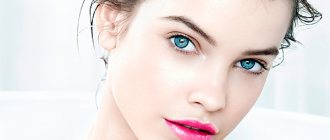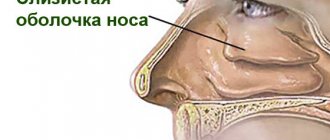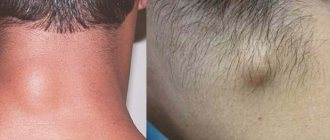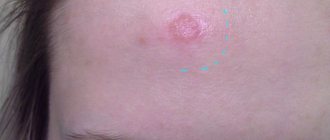A ball or lump under the skin on the forehead under the skin can mean anything. This includes a serious health condition such as cancer, a bone spur (osteoma), or just a sinus infection (sinusitis). Various bumps may appear between or above the eyebrows.
A subcutaneous formation that appears on the forehead usually does not cause any complications, and most of them go away without any medical help. A common cause of this problem is a sebaceous cyst. This is a tumor on the skin that occurs due to inflammation of the sebaceous glands. These bumps form when pores become blocked and fill with sebum and other dead cells.
Treatment for lumps under the skin always depends on the cause. For mild cases, ointments can be used. In other cases, they will quickly go away on their own. You should consult a doctor if itching occurs, the lump does not go away for a long time or begins to spread to other parts of the body.
Causes
Atheroma (sebaceous cyst)
Cysts are “sacs” filled with liquid contents
This is the most common cause of forehead balls or bumps. Cysts form on the sebaceous glands after they become clogged with yellowish sebum. They can go away on their own without medical help.
The cyst is not malignant and contagious. Atheromas grow slowly and are not life-threatening. Over time, they can become uncomfortable if their growth is not stopped. It is necessary to visit a doctor to make sure that the lump is not cancerous.
Treatment usually involves preventing severe symptoms and reducing the likelihood of future recurrences. The doctor may use a syringe to drain the atheroma or perform a surgical procedure. Topical and steroid medications may be used.
Osteoma
Osteoma - hard bone growth
Osteomas develop from bone tissue. They may occur at birth or develop over time.
The cause is unknown, but it is believed to be an inherited condition.
Osteoma is not a health problem, and the lump may go away on its own in less than a year. Therefore, the treatment is only given to those who have cosmetic concerns. A surgical procedure may be recommended to remove the tumor.
Treatment of osteoma
Osteoma forms when new bone grows on existing bone. The condition is common in children and young adults, but is rare in older people. Osteoma is a benign tumor, not cancerous, does not spread to other parts of the body and can go away on its own. Therefore, treatment does not involve removing the tumor, but reducing pain, which is its most common symptom.
The following treatment can be carried out:
- Treat pain and allow swelling to go away on its own
- Perform surgery to remove it
- Use radiofrequency ablation (RFA).
Lipoma
Lipoma is a soft, mobile formation consisting of adipose tissue
Lipoma (wen) is a harmless fatty deposit under the skin. They are mild and most are painless. They are also easy to diagnose compared to other skin conditions. Lipomas are not harmful, but a dermatologist can remove them if necessary.
People of any age are susceptible to this problem. It is classified as a benign tumor and is not contagious. The following are the characteristic features of lipoma:
- It is soft and movable when touched
- Grows slowly and does not spread to other parts
- Manifests itself in the form of bumps on the forehead (although it can generally form on any part of the body)
- Located under the skin
- They appear pale compared to the surrounding skin.
A biopsy is performed to diagnose the condition. In mild cases, such a formation does not pose any health risks or complications and therefore does not require treatment. However, if symptoms are bothersome, your doctor may prescribe one or more of the following treatment options:
- Surgical procedure
- Steroid injection for inflammation, both in joints and soft tissues
- Liposuction, in which a syringe is used to remove the fat forming the lipoma through suction
- Ointment for pain, itching and swelling
Cancer
Basal cell carcinoma (a type of skin cancer) on the forehead
Cancer refers to the formation of malignant tissue that begins to attack and damage neighboring cells. A common symptom is a painless swelling on the face. Cancer is a chronic disease. If you notice the following symptoms, you should seek medical help immediately:
- Painless lump on forehead
- A bump-like birthmark called melanoma
- Red dry bump
- A red, thick spot that may bleed frequently
- The spots increase in size
- Uneven spot.
The earlier cancer is diagnosed, the higher the chances of curing it. Depending on the type and severity, the doctor may prescribe chemical, radiation therapy or surgery to remove the formation.
Acne
Large, inflamed acne may resemble bumps on the forehead
Acne is a small, painful, red or pink bump on the forehead. They can appear as individual pimples or form groups. They form when skin pores become blocked and fill with dead cells and sebum. The resulting lumps can lead to acne or pimples.
The condition can be mild or severe. In the first case, a simple warm compress and aloe vera will help get rid of pimples and reduce the annoying urge to scratch them. On the other hand, severe acne can be treated with acne medications and antibiotics to reduce the chance of infection.
You should consult a doctor if symptoms persist or the pain and itching become unbearable.
Angioedema
With angioedema, bumps (swellings) usually appear not only on the forehead. The eyes, lips, tongue, entire face and even the airways may swell
Another possible cause of forehead lumps is angioedema, also known as angioedema, which involves swelling, itching, pain and burning. It can be caused by an allergic reaction to chemicals in food, insects, and medications that cause the body to release histamine.
Histamine in the body causes blood plasma to leak from the vessels into the skin, causing hives or angioedema. It may also be caused by a genetic disorder that may be inherited from parents.
Other reasons include;
- Pregnancy
- Anxiety or stress
- Extreme hot or cold temperature.
Treatment for angioedema will depend on its type and cause. However, common treatment options include:
- Avoid allergic triggers
- Antihistamines and steroids
- Automatic adrenaline injection for specific allergies.
For hereditary conditions, medications will be used to prevent and treat swelling.
Pimples on the eyebrows: determine the causes and begin treatment - medications, folk remedies, procedures
Pimples (in honey parlance they are called acne) lower self-esteem and spoil the mood of both sexes.
The occurrence of such a problem is a fairly common phenomenon, and depending on the location of the acne, the type and degree of inflammation, certain difficulties in the functioning of the human body can be found.
The topic of this article is pimples on the eyebrows of men and women, the reasons for their occurrence, prevention and elimination of the problem.
To fight pimples on the eyebrows, you need to find out the cause of their occurrence.
There are quite a few circumstances that can cause acne and they range from pollution to skin diseases.
| Causes of acne on eyebrows | Detailed description |
| Hormonal imbalance | Sebum is secreted better, which leads to clogging of pores and hair passages |
| Vitamin deficiency, hypervitaminosis | When there is an excess or deficiency of vitamins in the body, metabolic processes are disrupted, the sebaceous glands work unevenly, and the hair follicles become clogged. |
| Allergy | A fairly common cause of acne above the eyebrows and on other areas of the skin is an allergic reaction to various allergens. |
| Skin infections | The causes of inflammation on the skin can be dermatological diseases, infection of the body with parasites, fungal infections |
| Demodex mite infection | Pimples between and on the eyebrows may appear due to infection with a mite, which settles in the hair follicles and causes inflammation |
| Incorrect eyebrow correction | If the adjustment is carried out carelessly or the skin is very warm, acne may appear at the site of the removed hairs. |
| Reaction to cosmetics | The causes of acne under the eyebrows are often related to cosmetics. A rash on all areas of the facial skin can be caused by the use of bad cosmetics |
| Diseases of internal organs | Acne may appear due to liver disease and intestinal tract disorders |
| Spiritual Experiences | The presence of depression and stress often causes pimples on the bridge of the nose between the eyebrows |
Pimples between the eyebrows not only spoil the appearance, but also cause unpleasant, including painful sensations. It is important to know the cause of their appearance in order to correctly select treatment that can quickly and safely relieve the disease.
Pimples between the eyebrows and on the bridge of the nose don’t just appear. There are certain reasons and prerequisites for this. The main one is the clogging of pores with sebum, skin particles and dirt. Inflammation, blackheads and other types of pimples appear at the site of blockage. However, there are other factors:
- transitional (adolescent) age, when hormonal changes occur in the body in women and men;
- liver dysfunction;
- oily skin, when sebum is produced most actively;
- frequent touching of the skin on the face with dirty, dusty hands.
Pimples between the eyebrows come in different types: large and small, painful and painless, etc.
Painful formations may appear under the skin near the bridge of the nose and between the eyebrows. They look unattractive on the face. They can appear in men and women at any age. A lump under the skin can occur for various reasons.
Causes
A subcutaneous pimple like a lump in the eyebrow area can arise from the following:
- people do not properly care for their facial skin in general, causing active blockage of pores;
- rapid growth of hair follicles, especially with frequent eyebrow hair removal;
- hormonal imbalances;
- applying expired or low-quality cosmetics to the skin of the face;
- unfavorable environment and poor ecology;
- active work of the sebaceous glands;
- early onset of menstruation in women.
Symptoms
Pimples on the bridge of the nose on the right or left appear according to a certain pattern. If you know the symptoms in advance, you can prevent further development of inflammation. So, symptoms include:
- as soon as the inflammatory process begins under the skin, a small red bump appears on the skin between the eyebrows;
- initially there are no strong pain sensations;
- after a while the pain begins to increase, discomfort appears if you bring your eyebrows together;
- the pus inside the pimple begins to grow, which leads to the growth of the pimple;
- After 2-3 weeks, the process of “ripening” of the pimple ends and a white head forms on the surface of the skin.
Acne on the scrotum (testicles): causes and treatment
Treatment
How to quickly remove a subcutaneous pimple on the bridge of the nose? There are certain treatment methods for this:
- You should pay attention to your diet in order to eat less spicy, sweet, fried, smoked foods;
- use active skin antiseptic;
- all cosmetic products that clog pores should not be used;
- if the pimple does not go away for a long time, you need to consult a doctor for additional correct diagnosis;
- ointments that draw out pus, for example, “Vishnevsky” or “Levomekol” help;
- From folk remedies, you can try lotions made from aloe, water and salt, alcohol with propolis.
Pimples on the bridge of the nose can vary in size. Large formations are red bumps, most often with an abscess inside.
Causes
A large pimple between the eyebrows has a cause. Formations are most often provoked by bacteria and microbes. They penetrate clogged pores and begin to multiply in this favorable environment. The most common bacteria is staphylococcus.
Symptoms
Large pimples on the face develop, just like subcutaneous pimples. However, there may be no pain, since an abscess may not form.
Treatment
It makes sense to apply iodine to papules. This can be done up to three times a day. Pharmaceutical products such as Baziron AS, Differin, Zinerit are also effective.
If external remedies do not help, then after consultation with a doctor, oral antibiotics are prescribed.
Small pimples on the bridge of the nose are an unpleasant phenomenon from an aesthetic point of view. Yes, they can signal about various diseases. Small pimples may have the following external appearance:
- white bumps (comedones, milia);
- inflamed and non-inflamed red pimples.
Causes
Pimples on the forehead closer to the bridge of the nose and eyebrows appear for the following reasons:
- hormonal imbalances;
- disturbances in the functioning of the nervous system, lack of sleep, depression, stressful conditions;
- perhaps parasites live in the body;
- the onset of menopause;
- hereditary factor;
- poor nutrition;
- bad ecology.
Symptoms
There are always a lot of pimples above the eyebrows. However, localization can be on the cheeks and chin.
Treatment
How to get rid of pimples between the eyebrows that are small in size but appear in large numbers?
First, you should contact a specialist, for example, a dermatologist or cosmetologist. Oral medications or vitamins may be prescribed. A cosmetologist can perform facial cleansing, for example, chemical or mechanical, as well as ultrasound.
Establishing nutrition, getting rid of allergens in the house, keeping the home clean will also help stop active rashes on the face on the bridge of the nose.
They may also help:
- drying ointments;
- antiseptics;
- tinctures for compresses, for example, from calendula;
- applying aloe.
Red pimples on the bridge of the nose are the most common manifestation of acne, both in adults and adolescents. The pimples themselves are not very large, but they appear in groups and not individually.
Causes
Red acne has the following causes:
- improper functioning of the gastrointestinal tract;
- overeating fatty foods, sweet, smoked, spicy;
- smoking tobacco and excessive consumption of alcoholic beverages;
- disruption of hormones;
- stress, lack of sleep, neuroses;
- poor or no skin care;
Symptoms
On the skin of the face in the area of the bridge of the nose and forehead, red pimples appear painlessly if you do not comb or squeeze them.
Usually, itching and burning in the area of redness and rash are not observed. If you have any such symptoms, you should immediately consult a doctor.
Treatment
If acne appears in the form of red formations, then you can treat them as follows:
- contact a cosmetologist for cleaning and other procedures;
- refusal of decorative cosmetics during treatment;
- use of clay masks;
- the use of drying gels, ointments, lotions, for example, based on salicylic acid;
- apply compresses from a decoction of calendula, soda, and aloe.
Taking quick and prompt action to eliminate acne will help get rid of it in a short time.
What to do if unpleasant and painful pimples begin to appear on your eyebrows? Useful tips for women on how to get rid of this scourge. List of possible causes using an acne map. List of medications, salon procedures, folk remedies for acne.
Pimples on the eyebrows are a special cosmetic problem for all women: it is this area that is very difficult to disguise with makeup. Foundation and powder reveal themselves if they go into the hairline and look vulgar and unnatural.
Eyebrow tinting products turn out to be ineffective: no pencil or lipstick will cover this unpleasant growth - you will only spread the infection further and worsen their condition. However, there is no need to despair and give up. Pimples on the eyebrows need to be eliminated by eradicating the cause of their appearance.
Find out why eyebrow pimples have become your scourge. Determine the approximate time when you began to notice their appearance, and think about what events in your life they may be associated with.
Having determined the cause of their occurrence, you can direct efforts to eliminate it. Once it disappears, the pimples on your graceful eyebrows will also disappear. Firstly, you should think about your health, because problems with it manifest themselves in the form of acne, including in this area of the face. So, what does the acne map tell us:
- pimples above the eyebrows - intestinal disorders due to poisoning with poor-quality food, prolonged diarrhea or diarrhea;
- pimple under the eyebrow - the use of low-quality cosmetics that are either expired or cause an allergic reaction;
- pimples inside the eyebrows, between the hairs - vitamin deficiency;
- pimples between the eyebrows on the bridge of the nose - stress, emotional stress, nervous breakdown, prolonged depression;
- pimples on the forehead and eyebrows - hormonal imbalances associated with adolescence, pregnancy, menopause, and the use of hormonal contraceptives;
- pimple near the eyebrow - liver dysfunction.
Hard bump on forehead
Hard lumps on the forehead that feel like bone in most cases indicate osteoma. Osteoma, as stated above, is a benign tumor that is the result of bone tissue growth. The tumor can be found in any bony part of the body, but is more common in the legs.
Osteoma is common in children and adults, but is less common in people over 50 years of age.
In severe cases, when the pain becomes unbearable, the lump becomes large and does not go away after a month, you should immediately consult a doctor. Treatment options include a surgical procedure to remove such a bone tumor or radiation therapy, where radioactive energy will be used to destroy excess tissue.
Bumps that go away and come back again
Recurring subcutaneous lesions should be a cause for concern. They indicate an infection that does not go away. A common cause of this problem on the face is a sebaceous cyst. These are purulent tubercles formed on the sebaceous glands or pores of the skin.
They are not cancerous and are caused by infection or blockage of the sebaceous glands. You should clean the skin area around the lump with antibacterial soap, apply a warm compress twice a day for 20 minutes for a week, and avoid scratching or squeezing as this increases the likelihood of infection.
You should consult a doctor for additional diagnostics if the swelling does not go away after doing all these steps.
Alarming symptoms
A hematoma on a child’s forehead after a blow is fraught with many dangers. Most often they manifest themselves in a short time. A severe head injury in a child can lead to a concussion. Severe bruises result in cracks and fractures of the skull. Trauma can lead to rupture of blood vessels that penetrate the brain and internal hemorrhage.
If a child hits his forehead during a fall, the complexity of the injury will be indicated by the following points:
- even after 2-3 hours the child experiences pain in the head and neck;
- the baby is dizzy;
- the baby feels sick and vomits;
- he began to see worse;
- strabismus appeared;
- convulsions occurred;
- speech has become slurred, the baby confuses words and the order of sounds;
- bloody discharge from the ears and nose;
- pain after a bruise in a child does not decrease, but intensifies;
- it is difficult for him to turn his head;
- bleeding from the wound does not stop for 15-20 minutes.
These are symptoms that require immediate medical intervention. Only a doctor, using special diagnostics, will be able to determine the severity of the lesion and make the right decision.
Bumps on the forehead
Lumps on the forehead are most likely caused by any of the following:
- Acne, which is red, inflamed pimples on the sebaceous gland caused by infection. They can go away on their own without medical help.
- Cysts are lumps that form when the sebaceous glands become clogged with dead tissue, cells, and sebum.
- A pustule is a form of acne. They have no visible pores, are closed, red in color and surrounded by inflamed skin
- Boils on the forehead, most of which are caused by bacteria and can appear on the thighs, armpits and buttocks
- Stress and hormone imbalance
- Heat rash and sunburn, common in hot areas, occur when the pores of the skin become blocked, making it difficult for sweat to exit the body.
First aid for a forehead bruise
If a child hits his forehead hard, you should immediately conduct a visual inspection of the injury:
- A fall may cause scratches and abrasions on the forehead. The wounds must be treated with hydrogen peroxide. They can get infected, which will subsequently lead to an abscess, so treatment must be very thorough.
- Sometimes the consequences of a bruise go away on their own after a couple of hours.
- A bruise on the forehead indicates hemorrhage. If bleeding occurs as a result of damage to small vessels, then this is not dangerous. But it could be the result of a crack in the skull.
- If the wound on the forehead is deep and the bleeding is profuse, then immediately call for medical help, but often, children's injuries do not pose a danger.
A hematoma appears strictly at the site of the injury. Any nearby adult can provide first aid to a child within a few minutes. A hematoma can grow right before our eyes. The most urgent procedure is to stop the bleeding. The cold will help with this. The vessels will narrow, and the hemorrhage will become significantly less. There are two effective methods to stop internal bleeding from a forehead bruise.
The baby needs to be distracted before applying ice or a cold compress. A screaming child will interfere with the normal activities of adults. The pain from the bruise goes away quickly, and it is not difficult to distract the child. It is enough to turn on your imagination: tell a fairy tale, sing a song, remember fairy-tale characters who found themselves in negative situations.
If the baby experiences severe pain that does not go away for a long time, you need to show the child to a specialist so that he can do an examination and make sure that there is nothing dangerous. You need to visit a traumatologist urgently if your baby is bleeding from the ear canals and nose. Bleeding from the nose and ears after a bruise is a sign of damage to the skull.
Treatment
Treatment usually depends on the underlying cause. Most causes of bumps, such as heat rash, do not require treatment and go away on their own. Depending on what is causing them or how severe the symptoms are, treatment will include the following:
- Suitable ointments, including anti-itch agents, anti-inflammatory drugs
- Corticosteroid injection if allergy is the cause
- Antifungal creams
- Antibiotics for bacterial infections
- Skin moisturizers to prevent excessive sebum production or dryness, which is a common cause of sebaceous cysts
- Vitamin supplements to strengthen the immune system, which is the body's defense against infection and disease.
Most of the above products can be purchased without a prescription. But it is IMPORTANT that they are prescribed by a doctor after the cause of the bulges has been diagnosed. This will prevent the bumps from recurring and will also prevent the risk of a reaction to medications, which can be very harmful to your health.
Small itchy bumps
Small itchy balls are very common. They can be very painful and cause a lot of discomfort. Most of them do not require immediate medical attention, given the fact that they do not pose a health threat. But, of course, they have an impact on a person’s appearance and overall self-esteem.
Small, itchy bumps can be very contagious, such as the chickenpox or shingles viruses. Sometimes they can be triggered by heat rash or prolonged exposure to direct sunlight. These rashes are not harmful and can be treated with anti-itch ointments and creams.
Eating a balanced diet, drinking plenty of fruits and drinking fluids can also help keep the body functioning properly, strengthen the immune system and keep pores open. You should see a doctor if the rash continues for more than a week, as it is a sign of a medical complication.
My cancer life
Somehow it turned out that life, no matter how banal it may sound, was divided into before and after... Although nothing at all foreshadowed trouble.
I woke up one hot August day two years ago and the world turned upside down forever.
While washing my face, I felt a strange lump on my left eyebrow that definitely wasn’t there before. Frightened, I immediately rushed to the surgeon, without a number, without anything, stupidly at the end of the appointment.
The surgeon, an auntie who was very lazy to do her medical work, who saw me for the first time, first asked three times: “Where is the lump anyway? I don’t see anything!” After I literally poked her finger into the bump, she said that ACTUALLY YOU HAVE HAD IT HERE FOR A LONG TIME!! Let me remind you that the doctor’s auntie saw me for the first time in her life.
After pushing and explaining that she wasn’t here, only today the auntie got tired and started sending me to everyone, she said go to the ophthalmologist, to the ENT specialist, and then to the oncologist, but in general apply chlorhexidine to the lump and I don’t know what it is, goodbye. .
It was also impossible to get to the ophthalmologist without a number, since a dozen grandmothers were ready to quarter anyone who dared to enter except them. Therefore, for a week or two I gave up on the lump, and none of my friends still could see it or understand where it was.
Then I finally managed to get to the ophthalmologist, they said that everything was normal in their part, and they could not give me a referral for an x-ray, since it was not their jurisdiction, so to speak.
Another two weeks passed and I noticed with horror that the lump had grown and they were finally starting to notice it...
I went back to the surgeon without a number, and she wrote out a referral to an oncologist.
To an oncologist, oh, this amused me so much, what other oncologist I thought, why do I need him, well, it’s just funny!
If only I had known that from then oncologists would become almost my best friends..(
The oncologist ordered an x-ray, the x-ray did not show anything criminal, she ordered an ultrasound, they were so surprised at the ultrasound that they looked at me on two machines: a formation with uneven edges penetrating 10 cm into the bone.. They advised me to do a CT scan. I came to the oncologist, she was in a very hurry somewhere and just after looking at the ultrasound, she gave a direction to the oncology clinic..
My tumor, by the way, did not hurt, did not bother me at all except for its size and the fact that it was growing, and very quickly.
Oncological dispensary, oncological dispensary... I imagined this place as something gloomy, where everyone was crying and suffering, almost like an AIDS center, but such stupid associations I have.
At the oncology clinic, a kind girl, an ENT oncologist, looked at me and prescribed a CT scan.
Before I didn’t even know what CT and MRI were, but now I can tell everyone about it.
A CT scan showed the presence of some kind of formation. We decided to take a biopsy. Since it was impossible to simply poke with a puncture needle, I was fully placed on the operating table and, under local anesthesia, part of the tumor was cut off, leaving a three-millimeter scar above the eyebrow and wild swelling, which then subsided.
And so for the first time I came to that ENT girl’s office for bad news, there will be a lot more such trips later..
She called someone and, after listening to the histology results, quietly hung up.
Fibrosarcoma or anaplastic meningioma – her words rang in my ears. Life was over for me at that time. She said that a consultation with a neurosurgeon from the Republican Hospital, which was across the road, was necessary. For some reason, the word neurosurgeon scared me more than the fact that my tumor turned out to be malignant.
I left the office, sat on a bench and began to wait for the paperwork to go to that hospital. And without expecting it from herself, she began to cry bitterly. It’s so embarrassing, people are sitting around adults, and I’m 26 after all... Olgalor came out, saw that I was crying and began to calm me down. Having somehow calmed down, I went to a neurosurgeon and it turned out that these doctors weren’t so scary =)
The neurosurgeon reassured me and said that we would cut everything out and the scar would be invisible under the hair. The cut will be in a semicircle, where the bangs should be located, this part of the hair will be shaved off. Well, we need to prepare for the operation and do another MRI.
I told my mom everything right away, but my dad still doesn’t know that my tumor is malignant. He takes everything very close to his heart, especially as far as I am concerned, and we decided not to frighten him and hide it all (which is difficult for me and I am constantly bothered by the fact that he knows almost nothing about the real state of my affairs. .)
A long Google search on the Internet for fibrosarcomas and meningiomas did not bring anything good, both tumors were not the coolest and my fear grew. I didn’t cry anymore, I just prepared to die.
There is an operation ahead, and this is only the second time I will be in the hospital.
I won’t tell you for a long time everything went like everyone else’s: a standard set of tests, a queue at the emergency room, hospitalization, showing the ward, getting to know the neighboring patients.
Waking up in the intensive care unit from anesthesia, my leg hurt instead of my head, from the anesthesia and from such a surprise, I couldn’t do anything smarter than to cry.
“Nastya, why are you crying?” someone asked in the dark.
-Leg hurts..
In the evening I was transferred to the ward where I stayed for about two weeks.
The tumor was large, about 5 cm, they cut out a lot, the tumor penetrated through the skin into the bones, into the eye and a little into the brain, they cut out the bones of the forehead, which were replaced with bone cement. The left side stopped frowning - there were no muscles. Also, part of the head lost sensitivity and it was fun to knock on it
